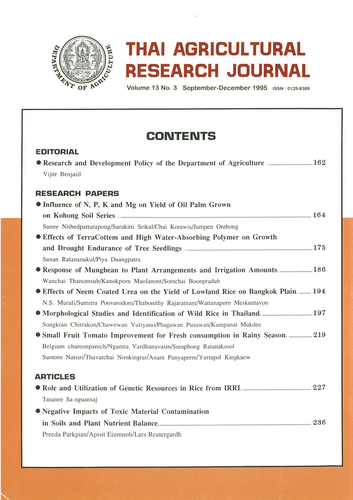Effects of Neem Coated Urea on the Yield of Lowland Rice on Bangkok Plain
DOI:
https://doi.org/10.14456/thaidoa-agres.1995.19Keywords:
Field experiments N fertilizers, Grain N uptake, N response.Abstract
Neem (Azadirachta indica A. Juss) seed extract is considered as a nitrification inhibitor, and is cheaper than the synthetic nitrification inhibitors. A local manufacturer has produced urea coated with neem seed extract. Two field experiments with cultivar Suphanburi-90 were conducted during the dry season from February to June 1994 at AIT Experiment Station, Bangkok, to evaluate the effects of neem coated urea on the yield of lowland rice. N was applied at 30 kg N/ha as basal application and 32.8 kg N/ha as topdressing and P was applied basal at 16.5 kg/harnThe first experiment consisted of four N sources viz. i) Ammophos (16-20-0) as basal and 21-0-0 as topdressing (AP+AM), ii) Urea (46%N) + triple super phosphate (TSP) as basal and urea as topdressing (Urea+Urea), iii) Neem coated urea (25%N, NCU)+ TSP as basal and NCU as topdressing (NCU+NCU), and iv) Urea+TSP as basal and NCU as topdressing (Urea+NCU) in a Randomized Block Design with five replicates. The grain yield showed no significant differences between the different N sources. Among the yield components, 1000 grain weight was decreased with NCU alone but number of panicles per m^2 and % filled grain were not effected by N source.rnThe second experiment comprised of three land preparation methods viz. i) Transplanted rice, ii) Wet seeded rice, and iii) Dry seeded rice with two N sources viz. urea and NCU in a completely randomized design with four replicates. Yield components and grain yield did not show any significant differences between urea and NCU. Furthermore, NCU showed no effect on either grain N uptake or N response.rnFrom these experiments it was concluded that NCU does not have an advantage over other sources of N for lowland rice on Bangkok plain.
Downloads
Published
How to Cite
Issue
Section
License

This work is licensed under a Creative Commons Attribution-NonCommercial-NoDerivatives 4.0 International License.
Thai Agricultural Research Journal



